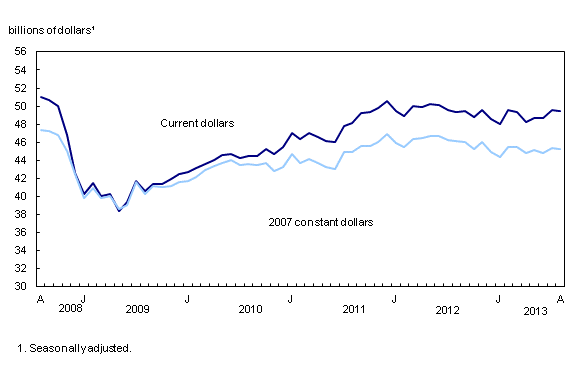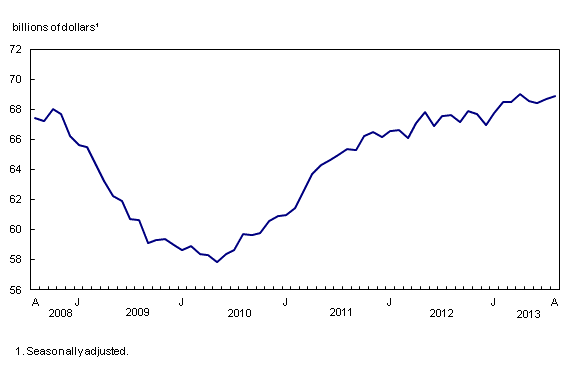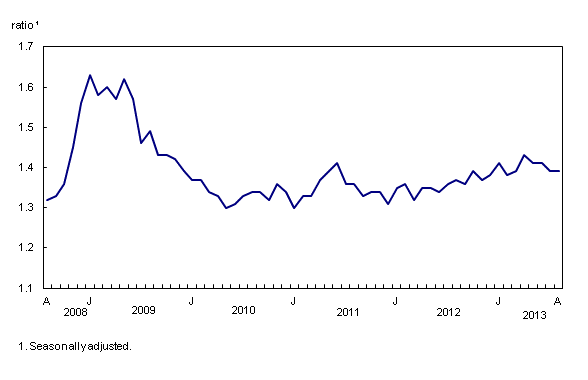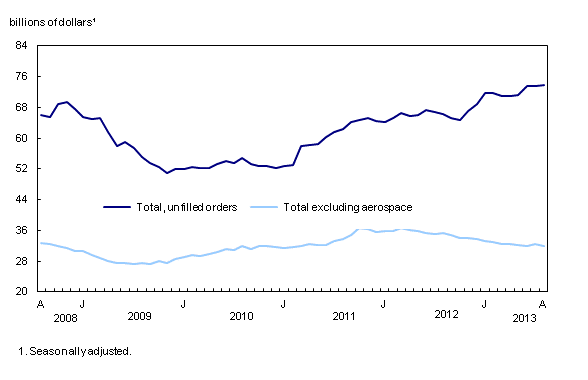Monthly Survey of Manufacturing, August 2013
Archived Content
Information identified as archived is provided for reference, research or recordkeeping purposes. It is not subject to the Government of Canada Web Standards and has not been altered or updated since it was archived. Please "contact us" to request a format other than those available.
Released: 2013-10-16
Manufacturing sales edged down 0.2% to $49.5 billion in August, following three months of gains. Sales were down in the miscellaneous, food and motor vehicle assembly industries. However, these declines were largely offset by gains in the aerospace product and parts and primary metal industries.
Sales were down in 11 of 21 industries, representing just over 40% of manufacturing sales.
Non-durable goods sales declined 0.7% to $24.6 billion while durable goods sales rose 0.4% to $24.9 billion.
Constant dollar sales fell 0.3%, indicating a slight decrease in volumes.
Drop in the miscellaneous industry offset by gains elsewhere
Sales fell 22.6% to $858 million in the miscellaneous manufacturing industry, more than reversing a 19.8% gain in July. Sales in this industry have been volatile over the past several months.
In the food industry, sales were down 1.6% to $7.1 billion. The largest decline was in the grain and oilseed milling sub-industry, as some facilities shutdown for part of August for maintenance work.
Motor vehicle assembly sales were down 2.5% to $4.4 billion. The decrease reflects smaller than usual gains in August following regular plant maintenance shutdowns in July.
The sales declines were largely offset by gains in the aerospace product and parts and primary metal industries. Aerospace production rose 17.8% to $1.5 billion in August, following a 17.1% decline in July. Production in the industry is often volatile.
In the primary metal industry, sales rose 3.0% to $3.6 billion. Most of the gain reflected higher volumes of product sold.
Sales decline in five provinces while Quebec posts gains
Sales were down in five provinces in August, with the largest decline in Ontario.
In Ontario, sales fell 2.1% to $22.5 billion. Almost 40% of the provincial decline was caused by a 28.4% drop in the miscellaneous manufacturing industry. Sales also declined in the motor vehicle assembly, chemical, machinery and food industries.
Sales in Saskatchewan decreased 6.0% to $1.2 billion, mostly as a result of a 14.2% drop in the food industry and a 12.8% decline in the chemical industry.
Quebec manufacturers reported a 3.2% gain to $11.6 billion, the third consecutive monthly increase. Prior to the recent advance, sales had declined in 10 of 12 months. Most of the gain in August was caused by an increase in production in the aerospace product and parts industry. Sales were also up in the petroleum and coal product as well as the primary metal industries.
In Alberta, sales rose 1.9% to $6.5 billion. Large gains were posted by the machinery, the petroleum and coal product as well as the fabricated metal product industries.
Inventories edge upwards
Inventories edged up 0.3% to $68.9 billion in August. Inventories have been moving upwards since the spring of 2010.
In the petroleum and coal product industry, inventories were up 5.3% to $6.3 billion. The gain stemmed from higher goods-in-process and finished product inventories on hand at a number of refineries.
Inventories rose 3.3% to $7.5 billion in the aerospace product and parts industry. The gain largely reflected higher levels of goods-in-process.
These gains were partly offset by a 2.0% decrease in inventories in the primary metal industry and a 1.4% decline in the machinery industry.
The inventory-to-sales ratio remained at 1.39 in August. The ratio measures the time, in months, that would be required to exhaust inventories if sales were to remain at their current level.
Unfilled orders rise
Unfilled orders rose 0.4% to $73.9 billion in August, the ninth increase in ten months. The gain in August was largely attributable to higher unfilled orders in the aerospace product and parts industry. Declines in the machinery and fabricated metal product industries offset much of the gain in the aerospace industry.
In the aerospace product and parts industry, unfilled orders increased 1.9% to $42.0 billion. The gain reflected a strengthening in the value of the US dollar relative to the Canadian dollar in August. A large proportion of aerospace unfilled orders are held in US dollars.
In the machinery industry, unfilled orders fell 4.0% to $8.3 billion, as a result of declines reported by a number of manufacturers. Fabricated metal product unfilled orders were down 1.8% to $6.1 billion.
New orders edged up 0.1% to $49.8 billion. A large gain in the aerospace product and parts industry was mostly offset by declines in the machinery, motor vehicle assembly and miscellaneous industries.
Note to readers
Monthly data in this release are seasonally adjusted and are expressed in current dollars unless otherwise specified.
Non-durable goods industries include food, beverage and tobacco products, textile mills, textile product mills, clothing, leather and allied products, paper, printing and related support activities, petroleum and coal products, chemicals, and plastics and rubber products.
Durable goods industries include wood products, non-metallic mineral products, primary metal, fabricated metal products, machinery, computer and electronic products, electrical equipment, appliances and components, transportation equipment, furniture and related products and miscellaneous manufacturing.
Production-based industries
For the aerospace industry and shipbuilding industries, the value of production is used instead of sales of goods manufactured. This value is calculated by adjusting monthly sales of goods manufactured by the monthly change in inventories of goods in process and finished products manufactured.
Unfilled orders are a stock of orders that will contribute to future sales assuming that the orders are not cancelled.
New orders are those received whether sold in the current month or not. New orders are measured as the sum of sales for the current month plus the change in unfilled orders from the previous month to the current month.
Manufacturers reporting in US dollars
Some Canadian manufacturers report sales, inventories and unfilled orders in US dollars. These data are then converted to Canadian dollars as part of the data production cycle.
For sales, based on the assumption that they occur throughout the month, the average monthly exchange rate for the reference month (noon spot rate) established by the Bank of Canada is used for the conversion. The monthly average exchange rate is available in CANSIM table 176-0064.
Inventories and unfilled orders are reported at the end of the reference period. Therefore, for these variables, the noon spot exchange rate on the last working day of the month is used for the conversion. The noon spot exchange rate is available in CANSIM table 176-0067. Because of exchange rate fluctuations, the monthly average exchange rate can differ substantially from the exchange rate on the last working day of the month.
The monthly average exchange rate is available in CANSIM table CANSIM table176-0064.
The noon spot exchange rate is available in CANSIM table CANSIM table176-0067.
Definitions, data sources and methods: survey number survey number2101.
Data from the September Monthly Survey of Manufacturing will be released on November 15.
The analytical article "Manufacturing: The Year 2012 in Review" is now available as part of the Analysis in Brief, no. 91 (Catalogue number11-621-M), series. From the Browse by key resource module of our website choose Publications.
Contact information
For more information, contact us (toll-free 1-800-263-1136; 514-283-8300; infostats@statcan.gc.ca).
To enquire about the concepts, methods or data quality of this release, contact Michael Schimpf (613-951-9832; michael.schimpf@statcan.gc.ca), or Elton Cryderman (613-951-4317; elton.cryderman@statcan.gc.ca), Manufacturing and Energy Division.
- Date modified:





